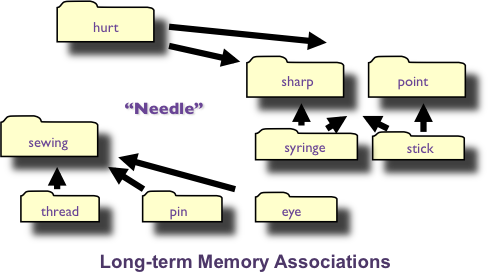Unlike working memory, our long-term memory has essentially unlimited storage time and capacity. Anything you put in here will be stored forever, and there is enough space to store everything. However, memory is based on storage and recall.
Having a place to put information has no value if we cannot find it later. A good storage system depends on good filing. Our long-term memory for facts and events is organized by the cross-connections or associations we make between the items in storage. For example, “needle” can be filed or associated by function or by appearance as you see in the image above.
For presenters, the secret of preparing and delivering a clear and memorable presentation is creating meaningful associations in the mind of the audience.
- Connecting the new ideas you present to what they know already. For each new idea, make sure you tell the audience how it’s the same and different from what they already know.
- Using lots of examples! If you can put them in real-world stories, so much the better.
- Relating the details of your presented information to the three or four key points they will keep in working memory.
- Connecting the key points of your presentation into a logical and memorable order.
Next time you sit down to prepare a presentation, take a moment to review the workings of long-term memory as well as sensory memory and working memory discussed in previous blog posts. By thinking about the audience’s ability to retain information first, it will become clearer what information to include (and not include).
